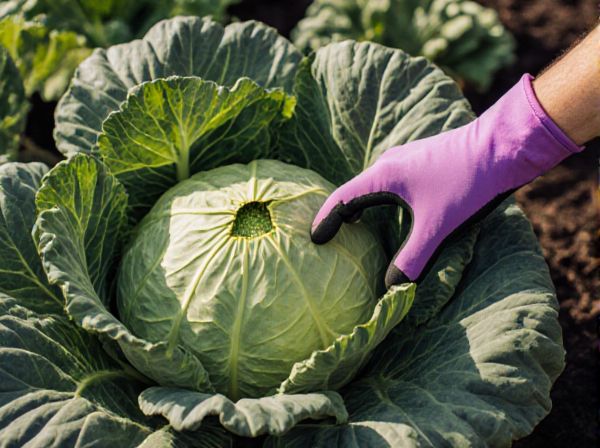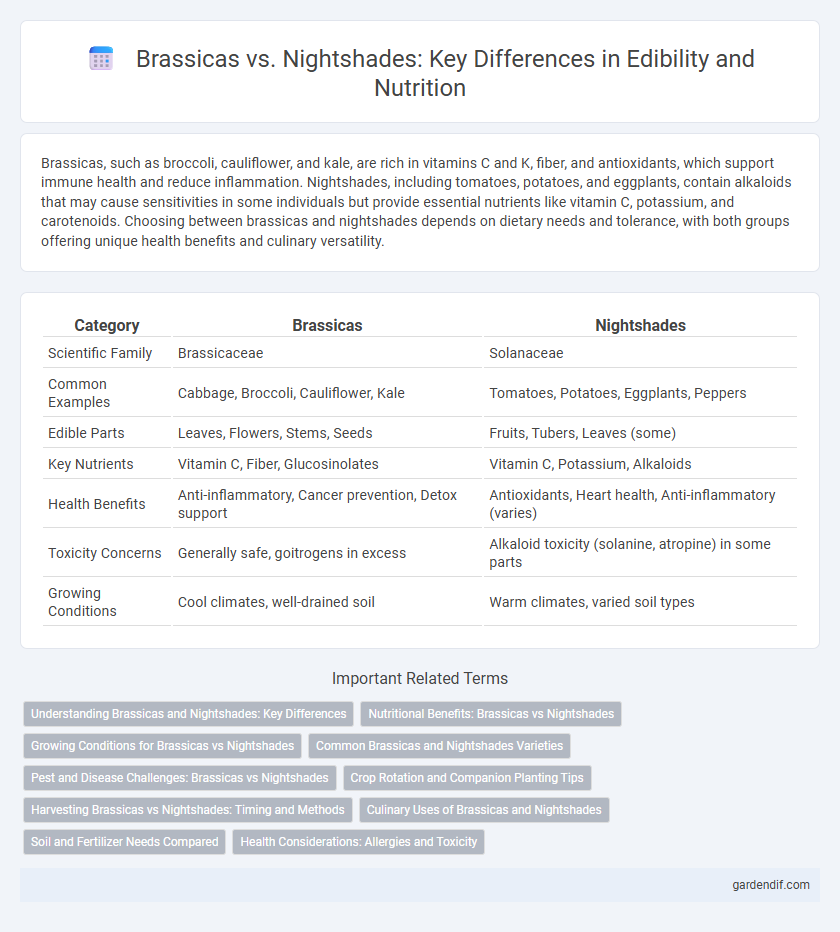
Brassicas vs Nightshades Illustration
Brassicas, such as broccoli, cauliflower, and kale, are rich in vitamins C and K, fiber, and antioxidants, which support immune health and reduce inflammation. Nightshades, including tomatoes, potatoes, and eggplants, contain alkaloids that may cause sensitivities in some individuals but provide essential nutrients like vitamin C, potassium, and carotenoids. Choosing between brassicas and nightshades depends on dietary needs and tolerance, with both groups offering unique health benefits and culinary versatility.
Table of Comparison
| Category | Brassicas | Nightshades |
|---|---|---|
| Scientific Family | Brassicaceae | Solanaceae |
| Common Examples | Cabbage, Broccoli, Cauliflower, Kale | Tomatoes, Potatoes, Eggplants, Peppers |
| Edible Parts | Leaves, Flowers, Stems, Seeds | Fruits, Tubers, Leaves (some) |
| Key Nutrients | Vitamin C, Fiber, Glucosinolates | Vitamin C, Potassium, Alkaloids |
| Health Benefits | Anti-inflammatory, Cancer prevention, Detox support | Antioxidants, Heart health, Anti-inflammatory (varies) |
| Toxicity Concerns | Generally safe, goitrogens in excess | Alkaloid toxicity (solanine, atropine) in some parts |
| Growing Conditions | Cool climates, well-drained soil | Warm climates, varied soil types |
Understanding Brassicas and Nightshades: Key Differences
Brassicas, including broccoli, cabbage, and Brussels sprouts, belong to the Brassicaceae family and are rich in glucosinolates, compounds known for their cancer-fighting properties. Nightshades, such as tomatoes, potatoes, and eggplants, come from the Solanaceae family and contain alkaloids like solanine, which can be toxic in large amounts. Understanding the nutritional profiles and potential sensitivities related to these families helps optimize dietary choices for health and culinary uses.
Nutritional Benefits: Brassicas vs Nightshades
Brassicas such as broccoli, kale, and Brussels sprouts are rich in vitamins C, K, and folate, along with glucosinolates that support detoxification and anti-inflammatory properties. Nightshades like tomatoes, eggplants, and peppers provide high levels of antioxidants including lycopene and vitamin A, which promote heart health and vision. Both families offer essential nutrients, but brassicas are particularly noted for their cancer-fighting compounds, while nightshades excel in antioxidant diversity.
Growing Conditions for Brassicas vs Nightshades
Brassicas thrive in cooler climates with temperatures between 45degF and 75degF, requiring well-drained, fertile soils rich in organic matter and consistent moisture to prevent stress and bolting. Nightshades prefer warmer conditions, growing best in temperatures ranging from 70degF to 85degF, with full sun exposure and slightly acidic, well-drained soils. While brassicas benefit from cooler, moist environments to enhance nutrient uptake, nightshades demand heat and moderate watering for optimal fruit development.
Common Brassicas and Nightshades Varieties
Common Brassicas, including cabbage, broccoli, cauliflower, kale, and Brussels sprouts, are nutrient-dense vegetables rich in vitamins C and K, fiber, and antioxidants. Nightshades such as tomatoes, potatoes, eggplants, and bell peppers contain alkaloids, including solanine and capsaicin, which can impact digestion for some individuals. Both Brassicas and Nightshades contribute distinct flavors and health benefits to diverse culinary dishes worldwide.
Pest and Disease Challenges: Brassicas vs Nightshades
Brassicas often face pest and disease challenges such as cabbage worms, aphids, clubroot, and black rot, requiring targeted insecticides and crop rotation to manage infestations. Nightshades, including tomatoes and eggplants, are commonly affected by pests like whiteflies, spider mites, and diseases such as blight and powdery mildew, necessitating vigilant monitoring and fungicidal treatments. Effective pest and disease management strategies differ significantly between brassicas and nightshades due to their unique vulnerabilities and growth habits.
Crop Rotation and Companion Planting Tips
Brassicas such as cabbage, broccoli, and kale thrive when rotated with nitrogen-fixing legumes to replenish soil nutrients and disrupt pest cycles specific to the Brassicaceae family. Nightshades like tomatoes, peppers, and eggplants benefit from rotation with members of the allium family, reducing soil-borne diseases common to Solanaceae crops. Companion planting Brassicas near aromatic herbs like dill or mint can deter cabbage pests, while planting nightshades alongside basil or marigolds enhances growth and repels harmful insects.
Harvesting Brassicas vs Nightshades: Timing and Methods
Brassicas such as broccoli, cauliflower, and Brussels sprouts require precise timing for harvesting to ensure optimal flavor and texture, typically when heads are firm and tight before flowering begins, using hand-harvesting techniques to avoid damage. Nightshades like tomatoes, peppers, and eggplants are harvested based on color maturity and firmness, often requiring multiple pickings over the growing season, with careful handpicking to prevent bruising and maximize shelf life. Proper harvesting timing and methods are critical for both Brassicas and Nightshades to maintain nutritional quality and reduce post-harvest losses.
Culinary Uses of Brassicas and Nightshades
Brassicas, including broccoli, cabbage, and Brussels sprouts, are prized in culinary applications for their robust flavors and versatility in roasting, steaming, and stir-frying, enhancing nutrient retention and texture. Nightshades such as tomatoes, potatoes, and eggplants offer diverse culinary uses ranging from fresh salads and sauces to baked and fried dishes, contributing vibrant colors and distinctive tastes to global cuisines. Both plant families provide essential vitamins and antioxidants, making them staples in health-conscious and gourmet cooking alike.
Soil and Fertilizer Needs Compared
Brassicas such as cabbage and broccoli thrive in well-drained, loamy soil with a pH between 6.0 and 7.5, requiring consistent nitrogen-rich fertilizer to support vigorous leaf growth. Nightshades, including tomatoes and peppers, prefer slightly acidic soil with a pH of 5.5 to 6.8 and benefit from balanced fertilizer formulas rich in phosphorus and potassium to enhance fruit development. Both families demand nutrient-rich soil but differ in pH preferences and specific macro-nutrient ratios, influencing fertilizer selection for optimal yield.
Health Considerations: Allergies and Toxicity
Brassicas such as broccoli and kale contain glucosinolates which can cause digestive discomfort in sensitive individuals, especially those with thyroid issues due to goitrogenic effects. Nightshades like tomatoes and eggplants may trigger allergic reactions or exacerbate inflammation in people sensitive to alkaloids such as solanine. Monitoring intake of both vegetable families is important for individuals prone to allergies or with specific health conditions related to these compounds.
Brassicas vs Nightshades Infographic

 gardendif.com
gardendif.com